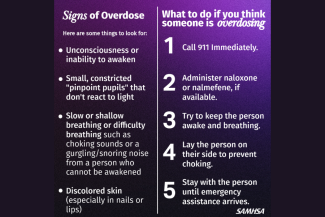Overdose Awareness Week and Your Workplace

During Overdose Awareness Week, we come together to remember the lives lost to overdose, support those still struggling, and take meaningful action toward change. This observance culminates on August 31 with International Overdose Awareness Day (IOAD), which is a global campaign dedicated to ending overdose, breaking stigma, and fostering hope.
While overdose often brings to mind events outside of work, the reality is sobering: overdoses happen in workplaces, too. In 2023 alone, there were 512 overdose deaths in U.S. workplaces—accounting for 9.7% of all occupational injury deaths that year.1 This increase has affected employees across all demographics, industries, and occupations.
Many of these deaths involve opioids, which can be prescribed for pain or obtained illicitly. Workplace conditions can play a role in substance use. Physically demanding jobs can lead to injuries and chronic pain, sometimes resulting in prescription opioid use, while high-stress environments can drive employees toward unhealthy coping mechanisms. Without intervention, these factors can significantly raise the risk of overdose.
What Employers Can Do to Prevent Workplace Overdoses:
- Identify and address workplace hazards to reduce injuries that may lead to pain and prescription drug use.
- Provide education for managers and employees on substance use risks, recognizing warning signs, and overdose prevention. Check out SAMHSA’s Overdose Prevention and Response Toolkit.
- Support employees with substance use disorders by offering access to Employee Assistance Programs (EAPs) and treatment resources.
- Collaborate with local health departments to connect employees to community-based prevention and treatment programs.
- Consider making naloxone available onsite and training staff to use it. Naloxone is a life-saving medication that can reverse an opioid overdose if administered quickly.
What Employees Can Do:
- Be aware of your company’s policies and resources for substance use prevention and support.
- Learn the signs of an overdose and how to respond.
- Speak up about unsafe working conditions or high-stress practices that could contribute to injury or substance use.
- Encourage colleagues to seek help without judgment.
As we honor Overdose Awareness Week and IOAD, let’s remember that every life lost is someone’s friend, family member, or coworker. By working together, employers and employees alike, we can create safer, healthier workplaces and help prevent the devastating impact of overdose.
Citations:
-
- U.S. Bureau of Labor Statistics. (2024, December 19). National Census of Fatal Occupational Injuries in 2023 (USDL-24-2564) [PDF]. U.S. Department of Labor. https://www.bls.gov/news.release/pdf/cfoi.pdf
Sources:
Centers for Disease Control and Prevention. (2024, September 26). Drug overdose deaths at work [Infographic]. https://www.cdc.gov/overdose-resources/pdf/DrugOverdoseDeathsAtWork_Full_Infographic.pdf
Overdose Prevention and Response Toolkit. (2025, July 1). SAMHSA Library. https://library.samhsa.gov/product/overdose-prevention-response-toolkit/pep23-03-00-001
U.S. Bureau of Labor Statistics. (2024, December 19). National Census of Fatal Occupational Injuries in 2023 (USDL-24-2564) [PDF]. U.S. Department of Labor. https://www.bls.gov/news.release/pdf/cfoi.pdf
Work safety topic: Overdose deaths - Injury facts. (2025, January 17). Injury Facts. https://injuryfacts.nsc.org/work/safety-topics/overdose-deaths/